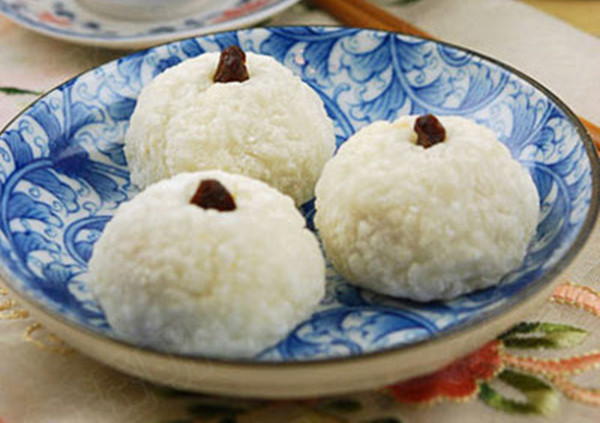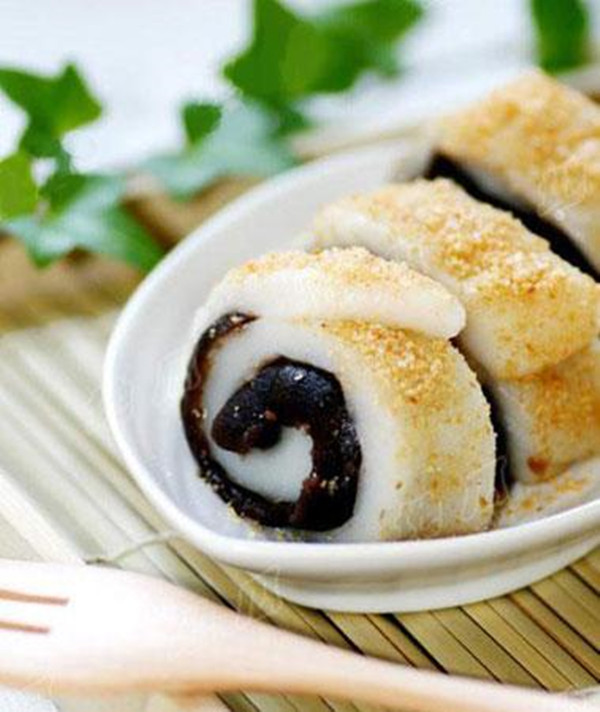Have you tasted Beijing snacks yet? Do you have any idea about the 13 most favored Old Beijing delicacies? These delicacies include Doumiangao, Aiwowo, Tangjuanguo, Jiangsipaicha, Tangerduo, Miancha, Sanzimahua, Hamatuomi, Tanghuoshao, Wandouhuang, Chaogan and Naiyouzhagao. Now let’s count them one by one.
Doumiangao

Doumiangao has a folk name: Lvdagun, which literally means a donkey that rolls about on the ground. In fact, the literal translation of Doumiangao should be Bean Flour Cake. How can you make one Lvdagun? First, prepare some glutinous millet flour and steam it. When you stir the flour, you need to add a little more water to make the flour soft. In addition, fry the soy beans you have prepared and then crush the fried bean into power. When you make the cake, you need to spread soy bean power on the surface of the steamed yellow millet flour and crush it into a piece with the rolling pin. Then, spread sweet red bean paste on it and roll it up, cut it into pieces with each being about 100 kg and then spray sugar on them. But why was it named Lvdagun? This is obviously a simile which tells us this cake is made like a donkey rolls about on the ground.
Aiwowo

Aiwowo is a stylish traditional Beijing snack, which will be produced before or after the Spring
Festival and it will last until the end of the autumn. This snack has a long history. During the reign of Emperor Wanli in the Ming Dynasty there was a snack named Wowo, which was produced in such a process: first, wash some glutinous rice, soak it, then put it into a food steamer to stead it, then take it out, make it cool and knead it well, divide it into several small parts, crush them into round pieces and then use these pieces to wrap prepared fillings which were made from peach kernel, sesame, melon seed, green plum, Jin Cake and sugar. But why was it named Aiwowo? A book written by a man born during the Qing Dynasty says that one emperor loved eating this snack and asked: “Yu Ai Wo Wo (御艾窝窝)”, which means preparing Aiwowo for me (the emperor). In Chinese, yu (御) is mostly often used for things related to an emperor. However, in ancient China, civilians were not allowed to share something important with an emperor. So, when Yu Ai Wo Wo was introduced to the folks of the country, they omitted Yu and only used Ai Wo Wo. Nowadays this snack is quite popular in Beijing.
Tangjuanguo

Tangjuanguo is also among the famous snacks in Beijing, especially popular with female eaters, and it literally means a fruit which is wrapped up by sugar. The main ingredients of it include Chinese yam, dates with green berry, peach kernel, melon seeds and so on. All these ingredients have medical values if valued by Chinese medicine. How to make this snack: prepare 1500 g of Chinese yam and chop it into pieces, prepare 500 g of dates whose cores must be removed, chop other prepared fruits into pieces, and then put all the chopped ingredients into one container and stir them and then add water and flour. Then, wrap up the stirred ingredients with tofu skins, steam them for 5 minutes, prepare one piece of cloth made of pure cotton, place the steamed ingredients on the cloth and make the cloth like a triangular strip. After it cools, chop it into pieces which are shaped like the fingers of a person. Next, pour them into the boiling oil and take them out after they become golden. In addition, pour oil, water, sweet-scented osmanthus, pour sugar into another pot, stew them with a small fire and put the fried fruits into the pot. Wrap it with the sugar juice and spread white sesames and sugar on it. It tastes really good.



